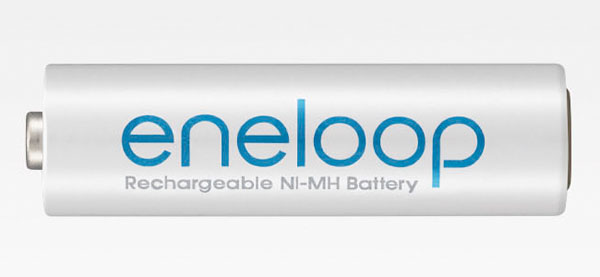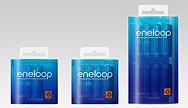
 |
| Home • Reviews • Forums • News 2015 • 2013 • 2012 • 2009 • 2008 • 2007 • 2006 • 2005 • 2004 RSS Feeds • FOV Factor Table • Sensor Sizes | Definitions: A-D • E-H • I-L • M-P • Q-U • V-Z | Sitemap Articles • Archived Websites (Pre-DigitalDingus): D100 Lounge • E-10 Club | Contact |
SANYO Presents 'eneloop' - New Battery to Replace Dry Cells for the 21st Century |
| November 4, 2005 |
 Tokyo, Japan, Nov 2, 2005 - (JCN Newswire) - SANYO Electric Co., Ltd. (TSE: 6764; NASDAQ: SANYY), the world leader in rechargeable batteries, announced a new next-generation nickel metal hydride battery 'eneloop' to be sold from November 14, 2005. This is the first product based on SANYO's new vision, 'Think GAIA'. Tokyo, Japan, Nov 2, 2005 - (JCN Newswire) - SANYO Electric Co., Ltd. (TSE: 6764; NASDAQ: SANYY), the world leader in rechargeable batteries, announced a new next-generation nickel metal hydride battery 'eneloop' to be sold from November 14, 2005. This is the first product based on SANYO's new vision, 'Think GAIA'.'eneloop' is a product that proposes a new lifestyle - one without disposing of batteries. Once charged, it can be used repeatedly, and once used completely, it can be recycled. To promote this kind of new battery lifestyle, SANYO developed a world first*1 rechargeable battery that can be used like a dry cell battery -'immediately after purchase'. Based on its new vision 'Think GAIA', SANYO is simultaneously pursuing solutions for a comfortable living and consideration for the environment and would continue providing 'Global Energy Solutions' and 'LOHAS (Lifestyles of Health and Sustainability) Solutions'.
Main Features
1. 'Immediately usable' new rechargeable battery
Batteries have a property to release the stored energy in small amounts (this phenomenon is called 'self-discharge'). This property is particularly noticeable in rechargeable batteries such as Nickel Metal Hydride Batteries etc. as compared to dry cell batteries, hence disabling rechargeable batteries from becoming batteries that 'customers can use immediately after purchase'. For this reason, rechargeable batteries couldn't be used unless charged after purchase and so lagged behind dry cells in convenience. This new product's main property is that it has introduced great improvements in self-discharge properties (residual ratio after one year of non use is 85%*4, in temperature conditions of 20 degree Celsius according to SANYO research). Through this breakthrough development, SANYO has realized a rechargeable battery that can challenge dry cell batteries in user-friendliness through features such as making possible use immediately after purchase or once charged, its ability to be used anytime.
SANYO has been a market leader in nickel metal hydride batteries for the consumer market. The synergy of the following proprietary technologies of SANYO in developing high capacity products has made the successful development of 'eneloop' possible:
1. high-performance negative electrode 'superlattice alloy'
2. make-up of battery material and battery plates
3. maintain quality despite being out of use for a long time
These are a few of the technologies that have helped contain self-discharge during the period for which the battery is not in use. Furthermore, it also inhibits voltage reduction even after a long period of being out of use.
2. An Environment-friendly product right from the battery to the packaging
In order to decrease the amount of waste to the least possible after the product is purchased, SANYO has achieved with this product, an eco-friendly product design, right from the battery itself to its packaging.
1) Can be used several times over, eliminating the hassle of disposing of batteries.
As a next-generation rechargeable battery that can be 'used immediately after purchase', and once charged, 'can be used anytime', 'eneloop' can be used in all devices that till date use dry cell batteries. Moreover, being rechargeable, 'eneloop'can be used 1000 times*3 over and without the need to dispose of the dry cell battery each time it is used up, it greatly reduces the troubles involved in the 'storage and disposal of used dry cell batteries'. Consequently, it makes a remarkable contribution to the reduction of 70,000 tons*5 of used dry cell batteries disposed annually in Japan alone.
2) Environment-friendly design that enables recycling, contributing to conservation of natural resources.
Being a rechargeable battery, 'eneloop' has a proper structure for recycling organized by industry groups, unlike dry cell batteries. Once used, 'eneloop' is collected, as rechargeable batteries have been, through prescribed recycle boxes installed at 30,000*6 electronics retailers throughout the country. Also, through an environment-friendly design, precious resources such as nickel etc. can be reused, thus contributing to efficient use and saving of resources.
3) Use of particularly environment-friendly and user-friendly battery tube and new package.
SANYO has created a tube and external packaging that is free from polyvinyl chloride. The outside packaging made with careful regard to the environment uses recycled PET material and only this material, thus eliminating any hassles when separating garbage at the time of disposal. Moreover, with a whole new original design of the battery tube and package, the battery pack is bound to change your image of battery packaging. Bearing in mind the reusability of the battery, the revolutionary design of the package makes the storage of these batteries more convenient after it has been opened.
3. Comparatively more powerful and longer-lasting than dry cell batteries. Superior low-temperature electrical discharge performance.
'eneloop' has been designed so as to extract a lot more power as compared to dry cell batteries. An experiment performed on SANYO's digital camera shows that using 'eneloop' can take 4.4 times*7 more pictures than a dry cell battery. Even under low temperature conditions (0 degree Celsius), when it is usually difficult for dry cell batteries to produce power, 'eneloop' displays superior power characteristics and longer power, making it a natural choice for outdoor use at ski resorts etc.
4. Economically more efficient than dry cell batteries, 'eneloop' can be used 1000 times over. Also, no need to worry about memory effect.
By recharging the 'eneloop', it can be used 1000 times*3 over and is comparatively more efficient economically than the use once and throw away dry cell batteries. Furthermore, the memory effect has only minor effects on the devices it is used on and hence can be used without worrying about the memory effect.
*1: According to SANYO Research, for Nickel Metal Hydride batteries on the market as of Nov. 1, 2005
*2: Figure based on SANYO brand products sold in Japan only
*3: Battery life based on testing methods established by JIS C8708 2004(4.4) (varies according to conditions of use)
*4: Simulation test based on a fully charged AA 'eneloop' battery left for one year at temperature conditions of 20 degree Celsius (Discharge condition: 740mA(E.V.=1.0V). Moreover, the product in use is SANYO's HR-3UF (Typ. 2500 mAh, Min. 2300 mAh).
*5: According to Battery Association of Japan' website
*6: According to JBRC's website
*7: Compared to SANYO's alkaline manganese dry cell battery (LR-6G). Conditions: Using SANYO's DSC-S4 digital camera. One picture every 20 sec. using the flash one out of every three times, LCD on, room temperature. However, depending on the camera and the conditions, the number of pictures will vary.
*8: Actual capacity based on charge/discharge levels as established by JIS C8708 2004 (4.2.1)
*9: Minimum Battery capacity based on charge/discharge levels as established by JIS C8708 2004 (4.2.1)
For more information, please visit the following Sanyo link:
http://www.sanyo.co.jp/koho/hypertext4-eng/0511/1101-2e.html |
| Home • Reviews • Forums • News 2015 • 2013 • 2012 • 2009 • 2008 • 2007 • 2006 • 2005 • 2004 RSS Feeds • FOV Factor Table • Sensor Sizes | Definitions: A-D • E-H • I-L • M-P • Q-U • V-Z | Sitemap Articles • Archived Websites (Pre-DigitalDingus): D100 Lounge • E-10 Club | Contact |